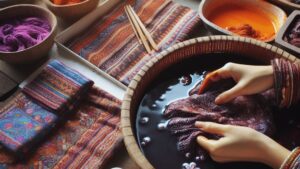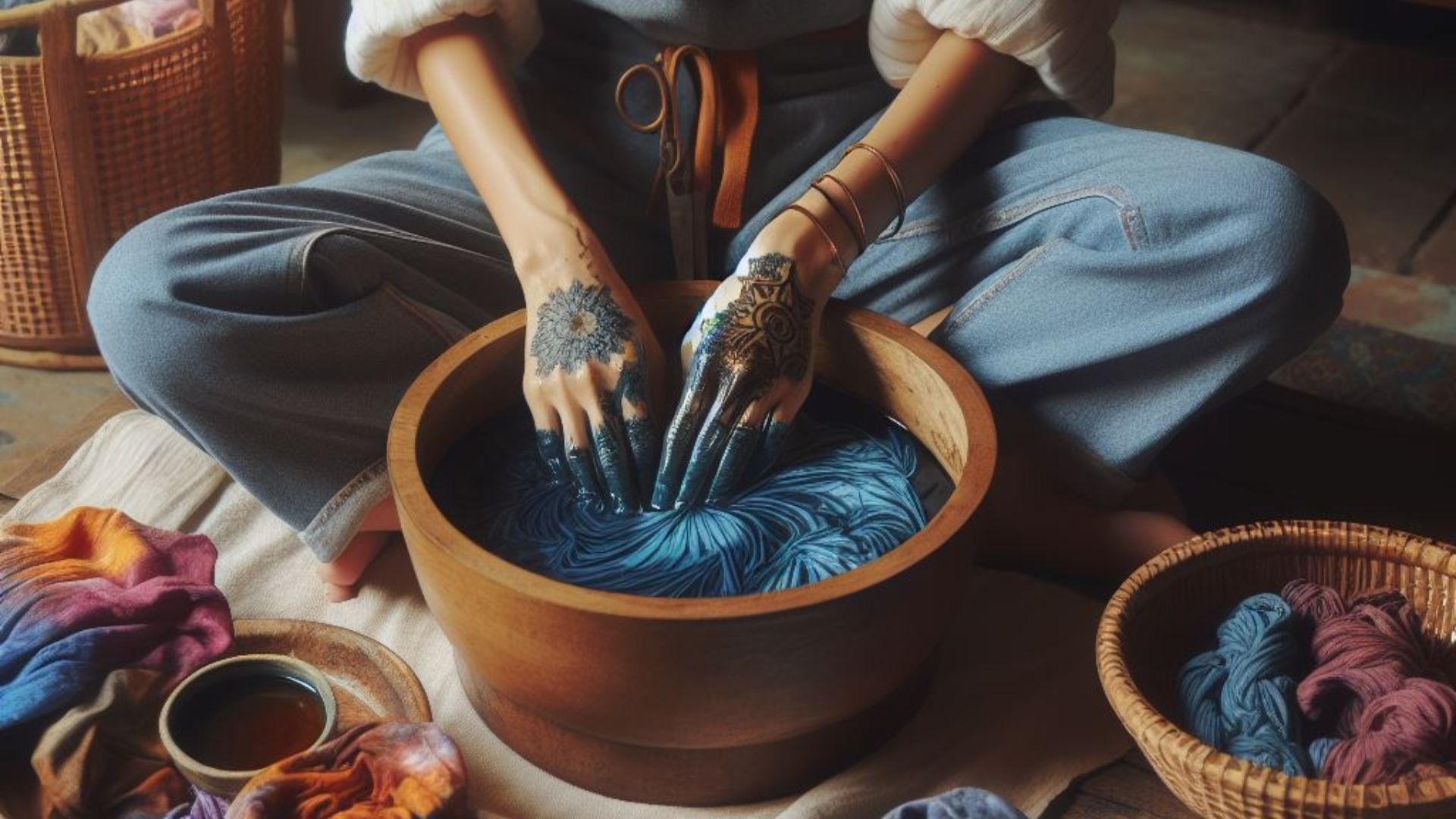Tie-dye, the vibrant and artistic process of adding color to fabric, is a beloved craft for many. But amidst the excitement of creating colorful patterns, concerns about bleeding colors can arise, especially when the setting time for the dye is shorter than recommended.
What is Setting Time in Tie-Dye?
Setting time is crucial in tie-dyeing. It refers to the duration required for the dye to bond with the fabric, ensuring the colors remain vivid and don’t bleed excessively when washed.
The Risk of Bleeding with Short Setting Times
A shorter setting time might result in incomplete bonding between the dye and the fabric fibers. This incomplete bonding could lead to several potential risks, including:
1. Color Bleeding:
- Risk: When the dye hasn’t properly bonded, colors are more likely to bleed onto adjacent areas or other fabrics during washing.
- Solution: Longer setting times typically ensure better color retention and less bleeding.
2. Fading:
- Risk: Inadequate setting time may cause colors to fade quickly, making the design lose its vibrancy after a few washes.
- Solution: Adequate setting time helps the dye penetrate the fabric deeply for longer-lasting colors.
3. Uneven Patterns:
- Risk: Insufficient setting time might result in uneven or patchy dye distribution, impacting the overall pattern quality.
- Solution: Optimal setting times ensure the dye spreads evenly, creating a cohesive and attractive design.
Ensuring Optimal Setting Time
To minimize the risks associated with short setting times and prevent bleeding:
1. Follow Instructions:
- Read and Follow: Always follow the manufacturer’s instructions regarding the recommended setting time for the specific dye you’re using.
2. Patience Pays Off:
- Allow Ample Time: Don’t rush the setting process; allow the dye to set for the recommended duration or longer for better results.
3. Test and Experiment:
- Trial Runs: Consider conducting small tests on fabric scraps to determine the optimal setting time for your chosen dye and fabric combination.

So,…
While a shorter setting time might seem appealing for quicker results, it often poses risks such as color bleeding, fading, and uneven patterns. To create vibrant and long-lasting tie-dye designs without the worry of bleeding colors, investing time in the setting process is crucial.
Each dye and fabric combination might have its own ideal setting time, so experimenting and following instructions diligently can result in stunning, colorfast tie-dye creations that stand the test of time.
External Resources:
- Craftsy – Tips for Perfect Tie-Dye
- Dharma Trading Co. – Tie-Dye Instructions
- WikiHow – How to Tie-Dye
Experiment, enjoy the process, and let your creativity shine without worrying about color bleeding by ensuring the right setting time for your tie-dye endeavors.
Understanding Tie-Dye Setting Time
Fabric Type Matters:
Different fabrics have varying levels of absorbency. Natural fabrics like cotton and linen tend to absorb dyes better than synthetic fabrics. Consequently, the setting time might differ based on the fabric you’re using.
Dye Variations:
Various types of dyes are available for tie-dyeing, such as fiber-reactive dyes, direct dyes, and natural dyes. Each type may require different setting times for optimal color retention and minimal bleeding.
Temperature and Conditions:
Factors like temperature and humidity in your workspace can also impact the setting time. Warmer temperatures can speed up the setting process, but rushing it might compromise the final result.
Importance of Washing and Curing:
After allowing the dye to set, washing and curing the fabric further enhance the colorfastness. Following proper washing instructions post-dyeing is crucial to remove excess dye and set the colors effectively.
Mitigating Bleeding Risks Beyond Setting Time
Apart from ensuring an adequate setting time, here are additional steps to minimize bleeding risks:
Use of Fixatives or Setting Agents:
Consider using fixatives or setting agents recommended for the specific type of dye to improve color retention and minimize bleeding.
Washing Techniques:
When washing your tie-dye creation for the first time, opt for a gentle hand wash or a machine wash using cold water. Adding a color catcher sheet can also help trap any loose dyes.
Careful Storage:
Store tie-dyed items separately or with similar colors to prevent color transfer. Avoid direct sunlight exposure, as prolonged exposure can fade colors over time.
Final Thoughts
Tie-dyeing is not just a creative process; it’s a science where various factors contribute to the final result. While a shorter setting time might seem like a time-saving option, it often leads to potential risks like bleeding colors, faded designs, and uneven patterns.
To achieve vibrant, long-lasting tie-dye creations that retain their brilliance wash after wash, investing time in the setting process and following best practices for dyeing, washing, and care is essential.
So, whether you’re a beginner exploring the world of tie-dye or an experienced crafter looking to enhance your techniques, remember that patience and attention to detail during the setting process can make all the difference in creating stunning and enduring tie-dye designs.
External Resources:
Comparison tabular on this
Here’s a comparison table that highlights key elements regarding tie-dye setting time and its impact:
| Aspects | Short Setting Time | Adequate Setting Time |
|---|---|---|
| Color Bonding | Incomplete bonding, leading to color bleeding and fading. | Stronger bonding, ensuring vibrant colors and minimal bleeding. |
| Pattern Quality | Potential for uneven or patchy patterns. | Even distribution, resulting in cohesive and appealing designs. |
| Fabric Impact | Greater risk on less absorbent fabrics. | Better results on a variety of fabrics, especially natural ones. |
| Dye Types | May vary in effectiveness across different dye types. | Ensures optimal results for various dye types. |
| Temperature Effect | Vulnerable to temperature variations, might not set effectively. | More reliable despite temperature fluctuations. |
| Washing Impact | Higher chances of color bleeding during initial washes. | More colorfastness, minimal bleeding during washing. |
| Post-Dye Care | Requires additional fixatives or care for color retention. | Better color retention post-washing, minimal extra care needed. |
This table offers a quick comparison between a short setting time and an adequate setting time, outlining how each aspect could be affected by the duration of the setting process in tie-dyeing.
Understanding these differences helps emphasize the importance of allowing adequate time for the dye to set, ensuring vibrant, long-lasting tie-dye designs without the worry of bleeding colors or faded patterns.
Wrapping up
In the colorful world of tie-dye, the setting time stands as a crucial step in ensuring your creations remain vibrant and intact. While a shorter setting time might seem tempting for quicker results, it often poses risks like color bleeding, faded designs, and uneven patterns.
By dedicating the right amount of time to the setting process, you’re not just ensuring a more vivid and enduring outcome but also preserving the essence of your creative expression. Whether you’re an amateur exploring the art or a seasoned tie-dye enthusiast refining your craft, patience during the setting time is the secret ingredient to stunning and long-lasting tie-dye designs.
Remember, it’s not just about colors and patterns; it’s about the journey of creation and the joy of wearing or displaying your unique, vibrant masterpieces. So, embrace the process, experiment with different fabrics and dyes, and allow your creativity to flourish while ensuring your tie-dye creations stand out brilliantly for years to come.

For over a decade, I’ve been Mike, an artist, crafter, and designer deeply immersed in the Croc world. I thrive on crafting unique, size-inclusive patterns, fostering creativity, and sharing them on ktforum.com. My designs aim to ignite your creative spark and delight you, ensuring clarity and ease of use through rigorous testing. Join me in expressing your creative flair and showcasing your craft with joy.
Related Posts
- Is There a Risk in Delaying Tie-Dye Setting After Application
Tie-dyeing is a vibrant and creative way to breathe life into fabrics, but timing is…
- Accelerating the Tie-Dye Setting Process: Hairdryer or Fan?
Tie-dyeing is an art form that’s not just about colors; it’s about patience and precision.…
- Understanding the Impact of Sunlight on Setting Tie-Dye
Tie-dyeing is a vibrant and creative way to add a burst of color to fabrics.…
- Tie-Dye Setting: Special Considerations for High-Altitude Areas
Tie-dyeing is a vibrant and creative way to add color and personality to fabrics. However,…

